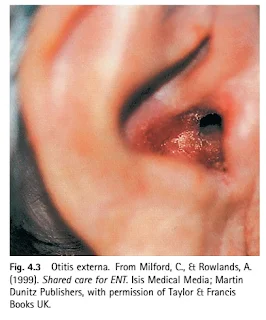Otitis Externa
Introduction
Otitis externa (Swimmer's Ear) involves inflammation and infection of the skin in the ear canal and is generally caused by bacterial infection.
- Otitis externa is 5 times more common in swimmers than non-swimmers.
Otitis externa can be precipitated by
- Ear trauma, e.g. scratching, foreign body and use of cotton buds
- Swimming, especially in dirty or polluted water
- Chemicals, e.g. hairspray, hair dyes, shampoo and drops of earwax
- Skin conditions, e.g. eczema, seborrheic dermatitis and psoriasis
Clinical Features
Otitis externa is characterised by itching and irritation, which, depending on the severity, can become intense. This provokes the patient to scratch the skin of the EAM (external auditory meatus), resulting in trauma and pain.
- Chewing and manipulation of the tragus and pinna can exacerbate pain.
Otorrhoea (ear discharges) follows, and the skin of the EAM can become oedematous, leading to conductive hearing loss.
- Otitis media (middle ear infection) is the most common cause of ear discharge and is usually mucopurulent. If discharge is present with otitis externa, discharge would not be mucopurulent.
On examination, the ear canal or external ear, or both, appear red, swollen or eczematous.
NOTE:
- Otitis externa should not present with any systemic symptoms. Fever and cold symptoms are often present in otitis media.
- Typically, the itch is often worse in a fungal ear infection than a bacterial ear infection.
Management
OTC treatment of otitis externa is currently very limited. Inflammation of the EAM would respond to corticosteroids and antimicrobial ear drops.
- May also use oral antihistamines to combat itching and irritation or analgesia (such as paracetamol or NSAIDs) to control pain.
Referral to Doctor
In severe cases of otitis externa, inflammation can spread from the outer ear canal to the pinna, resulting in perichondritis.
- Referral is needed because systemic antibiotics are required.


Comments
Post a Comment